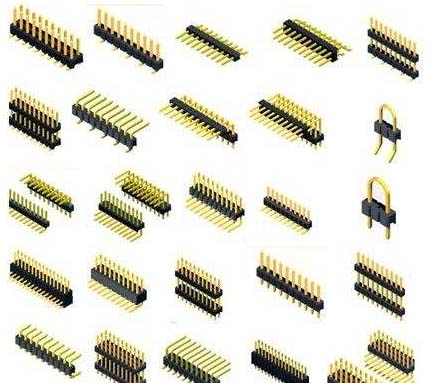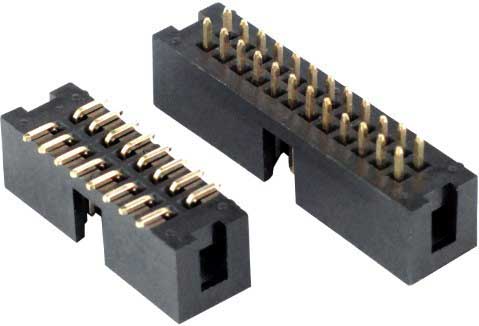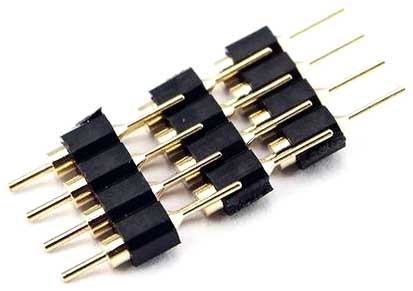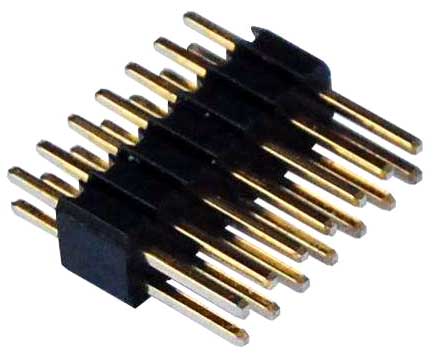Pin Header Characteristics And Parameter Classification
Pin headers are generally widely used in the connection of PCB boards and have the reputation of universal connectors. Generally used with it are Row mother, terminal block and other connectors. With the competition in the pin header market, some manufacturers are now starting from electroplating (imitation gold) and materials (green clad steel, alloy, etc.) to reduce costs, but also reduce the product's service characteristics and life.

Features of Pin-Header Connector
Pin header, a kind of connector, English name: Pin Header.
This kind of connector is widely used in PCB circuit boards in electronics, electrical appliances, and meters. Its role is to function as a bridge between blocked circuits or isolated and unconnected circuits, and to undertake the task of current or signal transmission. Usually used with female headers to form a board-to-board connection; Or it can be used with electronic wiring harness terminals to form board-to-wire connection; It can also be used independently for board-to-board connection.
Since the specifications required by different products are not the same, there are also many types and specifications of pin headers, which are classified according to the standard of the pin header connector of the electronics industry:

According to the spacing, it can be roughly divided into five types: 2.54mm, 2.00mm, 1.27mm, 1.00mm, 0.8mm. According to the number of rows, there are single-row needles, double-row needles, and three-row needles;
According to the packaging usage, there are SMT (horizontal paste/vertical paste), plug-in DIP (straight plug/bend plug), etc.;
Divided according to the installation method: 180° is represented by S, 90° is represented by W, and SMT is represented by T.
Number of rows: single row, double row, three rows, four rows, up to four rows.
Number of needles: 02to80
Pins: straight, bent, SMT; pin size.
Dimensions: overall dimensions length, width, thickness, row spacing.
Pitch: 0.8, 1.0, 1.27, 2.0, 2.54 pitch.
Material: refers to the material and surface treatment of the contact, Insulator material.

The cross-section of the rectangular pin is 0.8×1.6mm, and the load current is 7.5A. The jack has at least two independent shrapnels and four contact points. The jack structure can prevent misplugging. The cross-section of 254/I series square pin is 0.64×0.64mm. The above two kinds of pins are designed with obtuse corners and can be used in high-frequency technology fields. The pinhole contact part is gold-plated, anti-corrosion, low contact resistance and high reliability.

Features of Pin-Header Connector
Pin header, a kind of connector, English name: Pin Header.
This kind of connector is widely used in PCB circuit boards in electronics, electrical appliances, and meters. Its role is to function as a bridge between blocked circuits or isolated and unconnected circuits, and to undertake the task of current or signal transmission. Usually used with female headers to form a board-to-board connection; Or it can be used with electronic wiring harness terminals to form board-to-wire connection; It can also be used independently for board-to-board connection.
Since the specifications required by different products are not the same, there are also many types and specifications of pin headers, which are classified according to the standard of the pin header connector of the electronics industry:

According to the spacing, it can be roughly divided into five types: 2.54mm, 2.00mm, 1.27mm, 1.00mm, 0.8mm. According to the number of rows, there are single-row needles, double-row needles, and three-row needles;
According to the packaging usage, there are SMT (horizontal paste/vertical paste), plug-in DIP (straight plug/bend plug), etc.;
Divided according to the installation method: 180° is represented by S, 90° is represented by W, and SMT is represented by T.
Number of rows: single row, double row, three rows, four rows, up to four rows.
Number of needles: 02to80
Pins: straight, bent, SMT; pin size.
Dimensions: overall dimensions length, width, thickness, row spacing.
Pitch: 0.8, 1.0, 1.27, 2.0, 2.54 pitch.
Material: refers to the material and surface treatment of the contact, Insulator material.

Packing: blister pack, roll bag, bulk pack.
Material: pin material: brass or phosphor bronze; insulator material: plastic UL94V-0.
Surface treatment: 0.8u gold plating, tin plating, nickel plating.
Processing technology:
The main process of pin header processing is: First process the pins with brass (or phosphor bronze) as required, and then plate nickel and then gold as required, and then process the insulator part with a mold, and finally inlay the pins on the insulator according to the size requirements on the special equipment.
Remarks: There are many factors that affect the price, usually gold plating, needle length and so on.
Examples of pin header parameters
Features: single row and double row, straight needle and curved needle, the pin spacing is 2.54mm and 3.96mm, and various pin lengths.

Pin header application
●Data processing ●Computer ●Program control equipment ●Electronic measuring equipment ●Automatic control ●Automation ●Communication
Material: pin material: brass or phosphor bronze; insulator material: plastic UL94V-0.
Surface treatment: 0.8u gold plating, tin plating, nickel plating.
Processing technology:
The main process of pin header processing is: First process the pins with brass (or phosphor bronze) as required, and then plate nickel and then gold as required, and then process the insulator part with a mold, and finally inlay the pins on the insulator according to the size requirements on the special equipment.
Remarks: There are many factors that affect the price, usually gold plating, needle length and so on.
Examples of pin header parameters
Features: single row and double row, straight needle and curved needle, the pin spacing is 2.54mm and 3.96mm, and various pin lengths.

Pin header application
●Data processing ●Computer ●Program control equipment ●Electronic measuring equipment ●Automatic control ●Automation ●Communication
The cross-section of the rectangular pin is 0.8×1.6mm, and the load current is 7.5A. The jack has at least two independent shrapnels and four contact points. The jack structure can prevent misplugging. The cross-section of 254/I series square pin is 0.64×0.64mm. The above two kinds of pins are designed with obtuse corners and can be used in high-frequency technology fields. The pinhole contact part is gold-plated, anti-corrosion, low contact resistance and high reliability.





